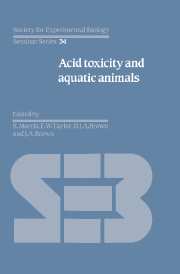Book contents
- Frontmatter
- Contents
- Contributors
- Units, Symbols and Formulae
- Preface
- Introduction: The causes and consequences of surface water acidification
- Invertebrate communities in acid streams
- Fish survival in acid waters
- Field studies on fisheries in acid waters in the UK
- Episodic changes in water quality and their effects on fish
- Acid–base regulation in fishes: 1. Mechanisms
- Acid–base regulation in fishes: 2. Biological responses and limitations
- Intracellular pH regulation and the effects of external acidification
- The physiological problems of fish in acid waters
- Laboratory studies on invertebrate survival and physiology in acid waters
- The physiological problems of crayfish in acid waters
- The effects of hydrogen and aluminium ions on fish gills
- The combined effects of pH and trace metals on fish ionoregulation
- Endocrine responses to acid stress in fish
- Commentary and conclusions
- Index
The physiological problems of crayfish in acid waters
Published online by Cambridge University Press: 05 February 2012
- Frontmatter
- Contents
- Contributors
- Units, Symbols and Formulae
- Preface
- Introduction: The causes and consequences of surface water acidification
- Invertebrate communities in acid streams
- Fish survival in acid waters
- Field studies on fisheries in acid waters in the UK
- Episodic changes in water quality and their effects on fish
- Acid–base regulation in fishes: 1. Mechanisms
- Acid–base regulation in fishes: 2. Biological responses and limitations
- Intracellular pH regulation and the effects of external acidification
- The physiological problems of fish in acid waters
- Laboratory studies on invertebrate survival and physiology in acid waters
- The physiological problems of crayfish in acid waters
- The effects of hydrogen and aluminium ions on fish gills
- The combined effects of pH and trace metals on fish ionoregulation
- Endocrine responses to acid stress in fish
- Commentary and conclusions
- Index
Summary
Introduction
The devastating effects of acid precipitation (resulting from the conversion of atmospheric oxides of sulphur (SO2) and nitrogen (NOX) to sulphuric and nitric acid), on lake fauna and flora have been well documented (Likens & Borman, 1974; Leivestadt et al., 1976; Harvey & Lee, 1982). Losses of freshwater fish populations from such affected areas have been recorded (see, for example, Leivestadt & Muniz, 1976; Harvey, 1979, 1982) and possibly because of their great economic value many physiological studies have concentrated on the effects of acid exposure on fish (reviews by Wood & McDonald, 1982; McDonald, 1983; Wood, this volume). Decreases in invertebrate populations have also been reported (Abrahamsson, 1972; Aimer et al., 1974; France, 1983, 1985), but this has stimulated rather few studies on physiological disturbances resulting from acid exposure in invertebrate animals. Interestingly, the few studies which have been undertaken have shown invertebrates to be more tolerant to acid exposure than fish, or more accurately, than those few, mostly salmonid, fish on which physiological studies have concentrated.
A second common feature of the fish studies is that they have mostly used sulphuric acid (H2SO4) as the acid stressor. While H2SO4 precipitation still remains a most serious problem, in recent years emission of SO2 have declined while those of NOX have continued to rise. Despite this, few studies of the physiological effects of nitric acid (HNO3) pollution on aquatic animals have been carried out.
- Type
- Chapter
- Information
- Acid Toxicity and Aquatic Animals , pp. 171 - 200Publisher: Cambridge University PressPrint publication year: 1989
- 10
- Cited by



